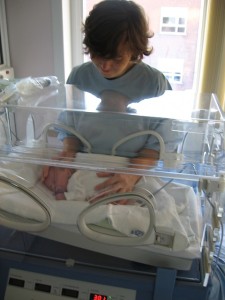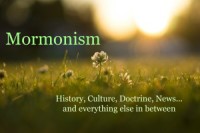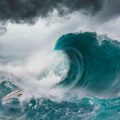One day I received a priesthood blessing in which I was told that God wanted me to know that He was aware I had received more than my fair share of trials over my lifetime. He also wanted me to know that He loved me and that every one of those trials had a purpose. Each one would allow me to serve others or to come closer to being the person He knew I could be.
I’ve thought often of that blessing. It came just after a series of trials that I sometimes thought I wasn’t going to get through, including the death of my father. I’d felt somewhat ignored or picked on by God during that time, even though, of course, I wasn’t, and had lost sight of the bigger picture. Over the years, I have come to realize that pain is a choice. Whether the pain comes from trials, or if they are from us feeling that someone is not behaving the way we want them to, we have control. We may not be able to control what happens to us, but we can control how we view it and how we use it.
 After several years of secondary infertility, with doctors uncertain I’d be able to have a second child, I gave birth to a little girl. Due to a very poor decision made by the hospital that was entirely financial in nature, my daughter was born not breathing on her own. I bled heavily, had two seizures, and coped with partial amnesia as a result of it all. The doctor had been furious with the hospital, so I’d known it was their fault.
After several years of secondary infertility, with doctors uncertain I’d be able to have a second child, I gave birth to a little girl. Due to a very poor decision made by the hospital that was entirely financial in nature, my daughter was born not breathing on her own. I bled heavily, had two seizures, and coped with partial amnesia as a result of it all. The doctor had been furious with the hospital, so I’d known it was their fault.
When it became evident that there were problems, I took my daughter back to the hospital. We had needed to move to a new state partway through the pregnancy for career reasons and no doctor would take me mid-pregnancy, especially with a high-risk history. The hospital sent not a doctor into the examining room, but a social worker who began to threaten me. She said all the baby’s problems were caused by me, that I was neglecting the baby, that I never wanted her, and that I hated her and was hoping she’d die. I was horrified and scared when she said that if I caused any trouble or tried to blame someone else, they’d have her taken from me.
No other doctor would see me until they released me and the next visit was handled by the head of the department who repeated the same story, as if she was trying to convince me to hate my child so I would blame myself.
Eventually, they decided I was convinced it was my fault and they let me go. After a series of appointments with other doctors who kept sending me to someone else, I forced a doctor to admit that my daughter had cerebral palsy and that this diagnosis had been made on the day of her birth, but hidden from me by the hospital and then by doctors who didn’t want to be the bearer of bad news.
The county provided a team of doctors who spent an entire day evaluating her disability before meeting with me in the evening. They told me I had grounds for a lawsuit and that they were putting into my file that the accusations of neglect had been the hospital’s attempt to keep me from suing them for causing the disability. However, they warned me that a lawsuit would require me to stay furiously angry for seven years. After thinking it over, I decided it would be spiritually dangerous to live a life of anger that long and I simply moved on to the work of raising a child with special needs.
 When she was two, I was invited to attend the training program that had provided me with a mentor–another mom who had been there and could listen and share experiences. I was told that although I’d attend the intense multi-day training, I would not be able to become a mentor until going through the program a second time one year later. I would have a very difficult assignment to complete in the meantime and no one was ever ready at the first training. I was puzzled, but agreed.
When she was two, I was invited to attend the training program that had provided me with a mentor–another mom who had been there and could listen and share experiences. I was told that although I’d attend the intense multi-day training, I would not be able to become a mentor until going through the program a second time one year later. I would have a very difficult assignment to complete in the meantime and no one was ever ready at the first training. I was puzzled, but agreed.
During the training, a psychologist asked us to share “the story.” Parents of special needs children know “the story” is how your child became disabled, how you learned about it, how you reacted, and how others treated you. Our stories were painful and hard to share and to listen to. Many of them were filled with anger and tears.
When we finished, the psychologist told us that all the first-year people were too filled with pain and anger to become mentors. Our assignment for the coming year was to work through the anger and pain to find peace and joy again. He said something I have never forgotten: “Until you get rid of the pain and anger, and until you forgive completely, you are incapable of serving another person.”
After the training, I sat down during the children’s nap times with a piece of paper. We’d been told to hand write a letter to the people we were angry at. When we were finished, we could mail it or throw it away, but the pain and anger were to go out the door with the letter. I knew the person I was angry at–the head of the department. She had made me feel terrified and incompetent at a time that should have been filled with joy and all for her own selfish reasons.
 I had chosen not to participate in the lawsuit because I knew I shouldn’t be angry for seven years–and yet I’d already been angry for two. That anger and pain had simmered inside all this time, impacting everything I did, including my spiritual life. I wrote the letter, pouring out all my feelings. Then, I did something very hard for me. I tore the letter into shreds and threw it away instead of mailing it. I removed the trash from the house and knelt to pray for help in getting rid of the anger and pain and to forgive. I knew I couldn’t forgive without help.
I had chosen not to participate in the lawsuit because I knew I shouldn’t be angry for seven years–and yet I’d already been angry for two. That anger and pain had simmered inside all this time, impacting everything I did, including my spiritual life. I wrote the letter, pouring out all my feelings. Then, I did something very hard for me. I tore the letter into shreds and threw it away instead of mailing it. I removed the trash from the house and knelt to pray for help in getting rid of the anger and pain and to forgive. I knew I couldn’t forgive without help.
Over the years, as even greater trials have come and I’ve had even greater reasons to experience pain and anger, I’ve remembered the words of that psychologist. “Until you get rid of the pain and anger, and until you forgive completely, you are incapable of serving another person.” He was right. My life changes for the better each time I choose not to be in pain.
It’s natural to have a time of grieving, but for some of us, grief, pain, and anger become a way of life. We begin searching for it in every aspect of our lives, even our religious life. Once we train ourselves to find things to be angry or hurt about, we begin seeing them everywhere, sometimes even when they don’t exist. I saw that happening in my own life and it was a struggle to stop. Pain is a choice–it can also become a habit.
I have come to realize that I can’t always understand what motivates other people. I can’t even always understand why God does the things He does. Sometimes His choices don’t make much sense to me, especially at first. Sometimes I have the opportunity to later realize He was right all along. Sometimes I accept that I won’t get it until I get to Heaven and He explains it to me.
In the meantime, I choose to try to see the good in the world, to focus on what I have instead of on what I don’t have, to trust God and His chosen servants…and to live a life of joy.
“Man is that he might have joy.” This is in the Book of Mormon. When I choose pain instead, I am rejecting one of the most important purposes in life.
Choose joy or choose pain? I choose joy.
About Terrie Lynn Bittner
The late Terrie Lynn Bittner—beloved wife, mother, grandmother, and friend—was the author of two homeschooling books and numerous articles, including several that appeared in Latter-day Saint magazines. She became a member of the Church at the age of 17 and began sharing her faith online in 1992.







